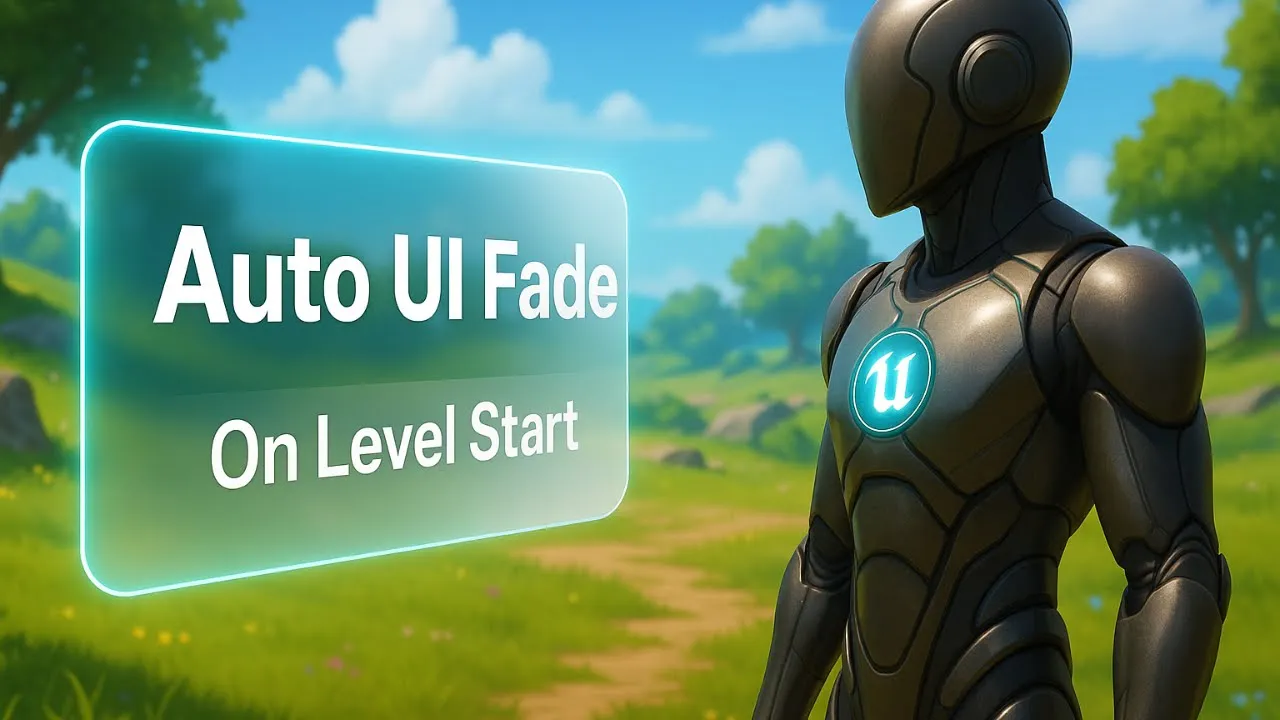
Make Your Game Look Awesome With This Simple Fade Trick!
Add automatic fade-in and fade-out animations to your Unreal Engine levels with Blueprints. Perfect for splash screens, title cards, and intro UI effects.
This tutorial shows you how to automatically play fade-in and fade-out animations when your level starts in Unreal Engine — no C++ required.
Using just Blueprints, you’ll prepare a UI widget, create fade animations in UMG, and trigger them from the Level Blueprint for a smooth intro effect.
This method is perfect for splash screens, title cards, or intro UIs that appear briefly on load and disappear without user input.
1) Preparing the Widget
- Create a Widget Blueprint (e.g.,
WBP_Title). - Inside it:
- Add a Canvas Panel as the root container.
- Add a Text Block → name it
Titleand set the text to"Title".
Creating Animations:
- In the Animations panel, make two:
- Fade In → Keyframe at 0s (Render Opacity = 0), Keyframe at 1s (Opacity = 1).
- Fade Out → Keyframe at 0s (Opacity = 1), Keyframe at 1s (Opacity = 0).
Now the widget has both fade-in and fade-out animations ready.
They will also appear as animation variables in the Graph, so we can trigger them from Blueprints.
2) Setting Up the Level Blueprint
Open the Level Blueprint for your map (e.g., ThirdPersonMap).
Step-by-step logic:
- Event Begin Play → fires when the level starts.
- Create Widget → select
WBP_Titleas the class. - Promote to Variable → name it
TitleWidget.- This keeps a reference so we can trigger animations later.
- Add to Viewport → displays the widget onscreen.
- Add a Delay (0.2s) → ensures the widget is fully ready.
- Play Animation (Fade In) → target =
TitleWidget. - Delay (1s) → lets the fade-in complete and the title stay visible briefly.
- Play Animation (Fade Out) → again targeting
TitleWidget. - Delay (1s) → allows fade-out to finish.
- Remove from Parent → cleans the widget from the screen.
3) Why Use Delays?
- The 0.2s delay ensures the widget initializes correctly before animation.
- The 1s delays sync timing so the animations don’t overlap.
- Without these, animations may look choppy or incomplete.
4) Expanding the System
This logic works perfectly for level start intros, but you can also:
- Trigger it from a Game Mode Blueprint.
- Use it in Player Controller for mid-game transitions.
- Reuse it for any UI widget that needs fade-in/out control.
5) Recap
We built a clean fade system with only a few Blueprint nodes:
- WBP_Title widget with two animations.
- Level Blueprint logic using Event Begin Play, Create Widget, Play Animation, Delays, and Remove from Parent.
- Automatic fade-in, hold, and fade-out effect at level start.
This is an easy but powerful trick for polished intros and transitions in your game.
Subtitle Expansion (Full Tutorial Flow)
“A viewer asked how to make a title fade in automatically when a level starts. I prepared a widget (
WBP_Title) with two animations: Fade In (opacity 0 → 1) and Fade Out (1 → 0). In the Level Blueprint, on Event Begin Play, I created the widget, promoted it to a variable (TitleWidget), added it to the viewport, and added a short delay. Then I played Fade In, waited a second, played Fade Out, waited again, and finally removed the widget. The result: the title appears smoothly at level start, fades in, stays briefly, fades out, and disappears automatically. Perfect for splash screens or intro cards.”
Wrap-Up
The fade trick is a must-have for creating professional-feeling intros, splash screens, or cinematic transitions.
It’s simple, reusable, and requires no Event Tick or extra systems.
👉 Watch the full tutorial here: YouTube Link
👉 More guides at: rambod.net
👉 Subscribe to Rambod Dev for more UI & animation tips.